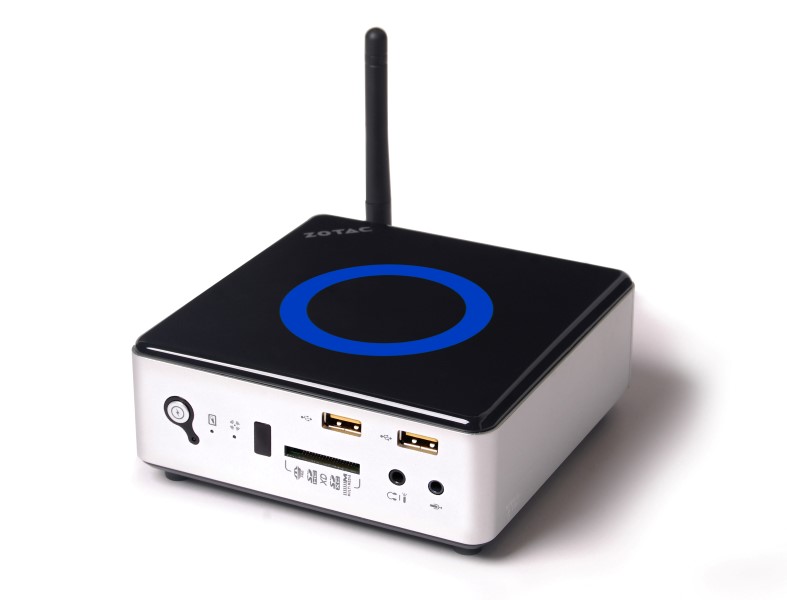ZOTAC Infuses ZBOX nano with Ivy Bridge
These little palm-sized PCs now have Ivy Bridge processors.

Zotac International said that it's now offering the ZBOX nano palm-sized PC with third-generation Intel Core "Ivy Bridge" processors. There are six SKUs in all, spanning two ZBOX ID63 models, two ZBOX ID64 models and two ZBOX ID65 models. Zotac said the Ivy Bridge processor injects the nano form factor with an extra dose of CPU and GPU performance that delivers an excellent mini-PC computing experience.
According to the specs, the ZBOX ID63 barebone and ID63 "Plus" models will sport a dual-core Core i3-3227U processor clocked at 1.9 GHz. The ZBOX ID64 and ID64 "Plus" models will have a Core i5-3337U dual-core processor (1.8 GHz, 2.7 GHz) and the ZBOX ID65 and ID65 "Plus" models will have a Core i7-3537U dual-core processor (2 GHz, 3.1 GHz).
Outside the processor differences, the ID63, ID64 and ID65 are the same, sporting an Intel HD Graphics 4000 GPU, HDMI and DisplayPort output, a 7-in-1 card reader, one eSATA port, Gigabit Ethernet, Bluetooth 4.0 and Wireless N connectivity. Two USB 2.0 ports are mounted on the front (one of which supports device charging), and four USB 3.0 ports on the back.
Additionally, the three models provide one 204-pin DDR3 SO-DIMM slot supporting up to 8 GB of DDR3-1600 memory. There's also support for one 2.5 inch HDD, or mSATA drives via the bundled nanoRAID storage adapter. This adapter accommodates two mSATA SSD modules and installs into the internal ZBOX nano 2.5-inch drive bay for "lightning-fast" RAID 0 or data-securing RAID 1 support.
As for the "Plus" designation, this means Zotac has also installed 4 GB of DDR3 memory and a 500 GB 5400 RPM 2.5 inch HDD. Thus, consumers have a choice of purchasing a barebones unit to add their own memory and storage, or one that's ready to go out-of-the-box -- no hardware installs needed.
"Our engineers have done a phenomenal job combining the raw CPU power of Intel Core processors and Intel HD Graphics 4000 into our tiny ZBOX nano platform. The performance and customizability available in these palm-sized ZBOX nano is unmatched by any of our competitors," says Carsten Berger, senior director, ZOTAC International.
The new Ivy Bridge-based ZBOX nano units will be made available later this month. Pricing will vary by region.
Stay On the Cutting Edge: Get the Tom's Hardware Newsletter
Get Tom's Hardware's best news and in-depth reviews, straight to your inbox.
-
Vorador2 Reply11163155 said:Sound like a good little HTPC,....how much though?
If it helps, i got a year and half ago an older version (nano ad10 with amd APU) for about 220€ without memory nor hard drive. -
InvalidError Single DIMM slot for HD4000? Seriously gimping DRAM bandwidth there. Most potential buyers probably wouldn't have minded the extra 3-5mm width for the 2nd DIMM and channel for double the max RAM bandwidth and total capacity.Reply -
that would actually be a nice desktop-solution for people like my parents. enough processing and graphics power for "internet"-stuff and video, quite user-servicable, efficient, hopefully not too loud, ssd+hdd...Reply
-
GreaseMonkey_62 Too bad they didn't go with the latest generation i processor. Better graphics and lower TDP.Reply -
dark_knight33 Reply11169361 said:Too bad they didn't go with the latest generation i processor. Better graphics and lower TDP.
Clearly you haven't used a haswell based cpu before. Despite having a lower claimed TDP they run generally hotter than IB cpus, and is likely the reason Zotac chose to use IB. -
InvalidError Reply
Haswell gets hotter than IB only under heavy load and the main reason for that is on-chip VRM.11171447 said:Clearly you haven't used a haswell based cpu before. Despite having a lower claimed TDP they run generally hotter than IB cpus, and is likely the reason Zotac chose to use IB.
Once you account for the part of motherboard VRM losses that are now on the CPU, total system power is roughly the same in most cases so the total heat that needs to get out of the box would be roughly the same.